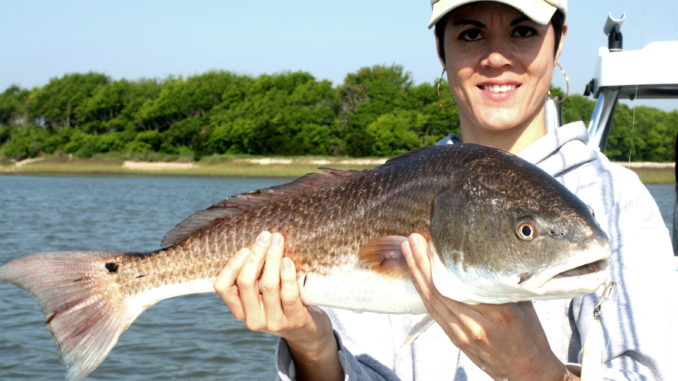
May is the month when redfish start hitting topwater baits in the waters around Charleston.
Kevin Blair fishes the waters around Charleston about 200 days a year, but his favorite days are in May when he can catch redfish on topwater baits.
“There’s nothing more exciting than catching reds on top,” said Blair, who guides for the Charleston Fish Rod Bending Company.
Two main factors are involved in catching reds on topwater baits around Charleston: temperature and tides. Reds can be caught on topwater baits as soon as the surface temperature reaches 65 degrees, and they’re liable to keep striking topwater baits until it reaches 80 degrees. Blair said there’s a three-hour window on the low end of the tide cycle when all the bait pulls out of the marsh grass, and that the two hours after sunrise is prime time to catch reds on top, unless it’s a cloudy day; then, they’ll bite all day. Put low tide and periods of low-light together and you’ve got conditions that will produce topwater reds.
At the outset of an incoming tide, Blair likes working along the grass, especially the grass in front of creek mouths, because the bait is getting ready to move into the creeks.
After the water rises about a foot on the early incoming tide, reds will usually hold about 2 feet deep around shelves, banks and flats. Blair will cast to all visible structures including oyster beds, pipes, rocks, trees or any type of debris in the creek.
“When the water is coming in, you want to fish the high banks with no grass,” Blair said. “Fish will hunt along the banks and feeder creeks coming into the river, especially ones running over oyster beds. (And) reds like stained water, but they don’t like dirty water.”
The topwater lure that Blair employs is a Super Spook Junior. in red/white, speckled trout and silver mullet colors. He said the primary forage for reds is mullet and glass minnows, and a Spook Junior is about the same size as those baitfish.
Blair spools on 15-pound braided line and ties to an 18-inch leader of 25-pound fluorocarbon with a double Uni-Knot. He believes the fluorocarbon leader is sensitive enough to deliver the necessary action to fish the bait with a traditional “walk-the-dog” action and rigid enough to keep the line from getting tangled in the lure.
Paired with a 7-foot, medium-light spinning rod and matching reel, Blair is ready for topwater action.
“You have to work the lure slow or fast depending on what the fish want that day and then try to duplicate it,” he said. “If the seagulls swoop down towards your bait, then you know that you are making a realistic presentation.”
To “walk the dog,” Blair lets the lure settle on the surface after casting, keeps his rod tip just above the water, then retrieves it in a series of short jerks of the rod tip that make the lure jump back and forth, reeling in the slack between jerks to make the lure swim in a zigzag pattern.
Blair believes this technique is successful because the lure never stops moving, and the fish never get a good look at it.
“When the wind adds a little rip on the water, walking the dog offers deceptively slow coverage,” said Blair. “The lure is hard to identify, and there is always the chance of a reaction strike.
“Generally, an angler will miss a lot of reds because it is so hard for them to eat the bait. Because reds are bottom-feeders, their mouth is low, and they literally have to attack the bait underneath and upside down.”
While fishing along the grass, Blair will make a cast, let the Spook sit, then twitch it three times, stop and twitch it again.
“Drop and pop on medium speed, then vary the speed until you find what the fish want that day,” Blair said.
When the incoming tide pulls the water level up several feet, Blair will switch from topwaters to other artificials, explaining, “If they aren’t hitting on top, then they are holding on bottom.
“Position the boat so the wind is coming from behind and keep a low profile. The cast needs to be low and straight. When retrieving the lure, the line needs to be tight to prevent wind knots especially when throwing light lures.”
Blair uses a variety of lures, including a Z-Man paddletail in red bone, mullet, or black/silver or a Z-Man StreakZ on a ¼-ounce jighead. If fish are inactive, Blair will downsize to a 1/8-ounce jighead with a Z-Man scented shrimp or a Z-Man FattyZ on a 1/8-ounce flutter hook.
Blair will cast around grass or oyster beds, and once the lure hits bottom, he will twitch it to give it some action. Then he slowly works the lure along the bottom.
When using artificial lures, Blair uses a 7 ½-foot medium-light rod with 15-pound braid tied to a 20-inch, 20-pound fluorocarbon leader.
Sight-fishing for tailing reds on the flats is another technique that Blair looks for fish. Tailing reds are feeding fish on the bottom with their tails sticking up. The angler can see the fish on the flats moving in and out of the dark water. Blair says to work the bait slow and look for that big fish looking for one big meal.
On the flats these fish school in packs and cruise in 1 to 3 feet of water.
“You have to stay off the fish. Position the boat so your back is to the wind and make long casts so as to not spook the fish,” Blair explained. “Fish the edge of the rips, and cast 3 feet behind the rip.”
Just before high tide, the reds will move back in the creeks. Since reds are bottom-feeders, they can be seen chasing bait in the grass. When the water is 10 to 12 feet deep, Blair looks for “nervous water” which are reds making a slow wake.
“Reds are always moving and looking for something to eat. They can warm up in the grass and also escape the dolphins. The angler has to be very quiet so as not to spook the fish,” Blair said. “Pole in slowly, let the Power Pole down and wait on the fish.”
“Reds can average between 15 to 30 inches, and an angler can catch two or three out of the same area before they shut down, but if the fish are given a break, you can leave and come back and catch more as long as the bait is still there. If the fish spot you, move out and start to a new spot. Sometimes you have to move from a spot, and then cast back out where you were to get a strike.”
Depending on the tides, Blair will fish a variety of places, but some of his favorites include Hobcaw Creek and Hamlin Sound near Mount Pleasant; the Wando River — especially below the Navy Yard — Stone Inlet near Folly River, Morris Island and creeks near the lighthouse, the Cooper River, Clouder Creek near Daniel Island, the area behind Sullivan’s Island and Isle Palms on the Intercostal Waterway.
DESTINATION INFORMATION
HOW TO GET THERE — Charleston is at the junction of the Ashley and Cooper rivers. US 17 from north and south along the coast and I-26 from inland are the best access routes. Public boat ramps at Remley’s Point and Shem Creek in Mount Pleasant and Wappoo Cut south of Charleston all offer access to the fishing grounds.
WHEN TO GO — Reds are caught year-round in the Charleston area, but the best time to catch them on topwater is when the water warms between 65 to 80 degrees around the last of April and into May.
BEST TECHNIQUES — A 7 ½-foot, medium-light action spinning outfit spooled with 15-pound braid tied to an 18- or 20-inch leader of 20- to 25-pound fluorocarbon is best for casting artificials. To fish live or cut bait under a popping cork, use 20- to 25-pound braid with a 25- to 30-pound fluorocarbon leader. When fishing on bottom, use enough split shot to keep the bait down with a No. 2 or 3 circle hook.
FISHING INFO/GUIDES — Capt. Kevin Blair, Charleston Fish Rod Bending Comapny, 843-696-4231, www.charlestonfishrodbendingcompany.com; Capt. Tom Siwarski, Carolina Aero Marine Adventures, 843-327-3434, www.carolinaaeromarine.com; Capt. Chris Orvin, Overdose Fishing Charters, 843-509-2306, www.overdosefishingcharters.com. See also Guides and Charters in Classifieds.
ACCOMMODATIONS — Charleston Convention and Visitors Bureau, www.charlestoncvb.com.
MAPS — Capt. Segull’s Nautical Charts, 888-473-4855, www.captainsegullcharts.com; Sealake Fishing; Guides, 800-411-0185, www.thegoodspots.com; Maps Unique, 910-458-9923, www.mapsunique.com.

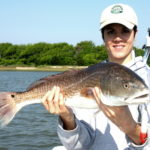
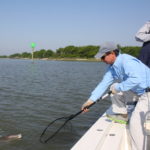
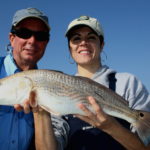
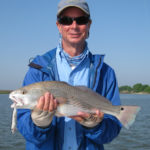
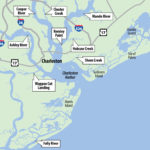



Be the first to comment